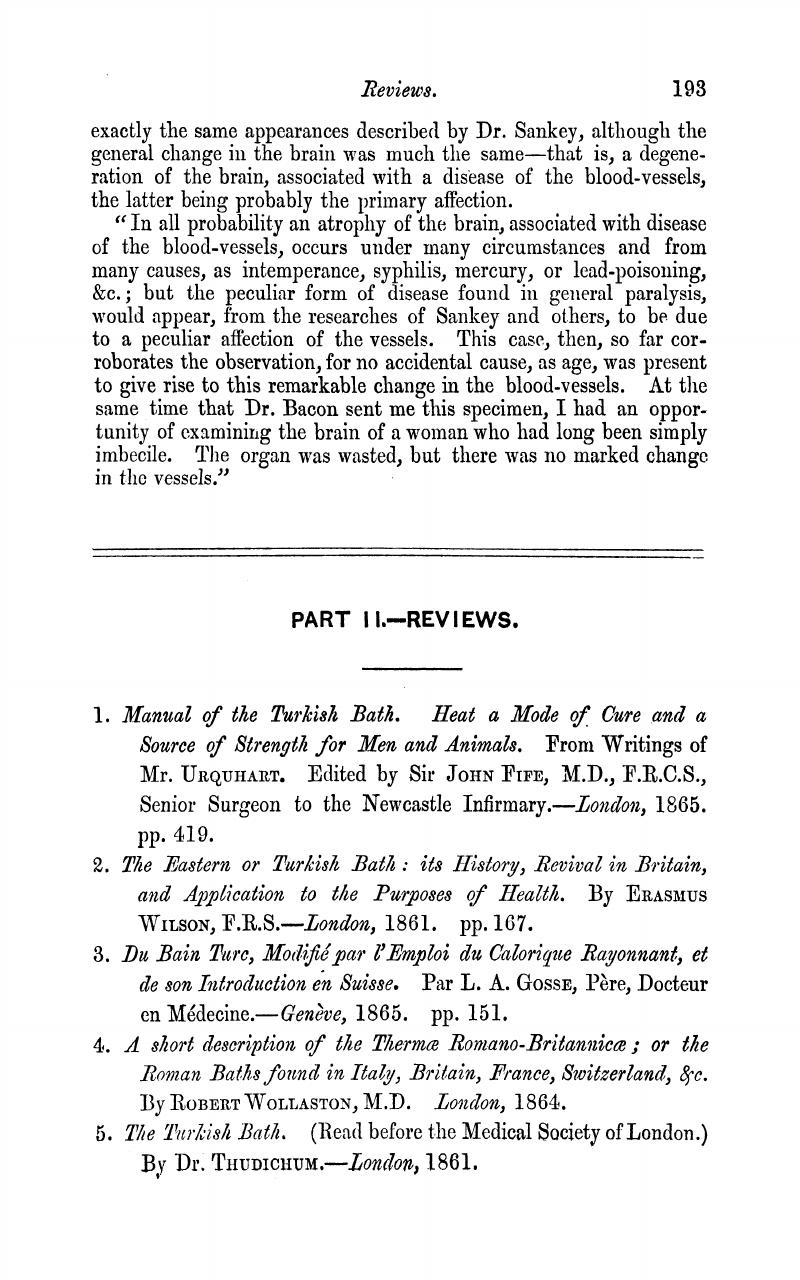No CrossRef data available.
Article contents
1. Manual of the Turkish Bath. Heat a Mode of Cure and a Source of Strength for Men and Animals. From Writings of Mr. Urquhart Edited by Sir John Fife, M.D., F.R.C.S., Senior Surgeon to the Newcastle Infirmary.—London, 1865. pp. 419. - 2. The Eastern or Turkish Bath: its History, Revival in Britain, and Application to the Purposes of Health. By Erasmus Wilson, F.R.S.—London, 1861. pp. 167. - 3. Du Bain Tarc, Modifié par l'Emploi du Calorique Rayonnant, et de son Introduction en Suisse. Par L. A. Gosse, Père, Docteur en Médecine.—Genève, 1865. pp. 151. - 4. A short description of the Thermæ Romano-Britannicæ; or the Roman Baths found in Italy, Britain, France, Switzerland, &c. By Robert Wollaston, M.D. London, 1864. - 5. The Turkish Bath. (Read before the Medical Society of London.) By Dr. Thudichum—London, 1861. - 6. The Anglo-Turkish Bath; with Practical Suggestions, and When it should be Employed. By York James Moore, M.R.C.S., &c. —London, 1861. pp. 58.
Published online by Cambridge University Press: 19 February 2018
Abstract

- Type
- Part II.-Reviews
- Information
- Copyright
- Copyright © Royal College of Psychiatrists, 1865
References
∗ ‘Manual,’ pp. 276-7.Google Scholar
∗ ‘Gout, a true blood-disease, is said to be unknown amongst the Turks; and this exemption is probably as much due to the free action of the skin caused by the bath as to their temperate habits. In estimating the value of the bath, however, as a curative agent, the special effect of caloric are to be taken largely into account. The effects of the higher degrees of heat possess a great, but as yet an almost unrecognised importance.”—Dr. Leared, from the ‘Lancet,’ November and December, 1863. [‘Manual,’ pp. 259-60.]Google Scholar
∗ ‘Manual,’ p. 3.Google Scholar
† The following is an account given of the “sweating-houses” by an old gamekeeper :— “In the county of Fermanagh I could take you to ten or a dozen of them. They are built in the form of a bee-hive; turf is burnt on the floor till it is clear, then they close up the hole and leave it for a time. When you are going to take the heat, the turf ashes are swept out, and the floor covered with rushes. You go in, and get towels and wipe the sweat off, and so on, till it is time to come out. Some knowledgable body is there that tells you when to come out, and you then jump into a stream of water; or if there is no natural stream, water is led, and a hole made for it. There was a man there, a strong (rich) farmer, and he built one for himself, and brought water through it in pipes. These houses were first made by the ancient Milesians, long before your bath was thought of.”—4 ‘Manual,’ p. 403.Google Scholar
∗ ‘Du Bain Turc,’ p. 67.Google Scholar
∗ “In a chemical analysis of the perspiration of a group of bathers, recently made, that fluid was found loaded with saline and organic matter in the recruits, but was almost pure in the veteran bather : his blood was washed as clean as that of the working man who eats the bread of labour—that sweetest of all bread, the bread that has been earned with the sweat of his brow.”—‘The Eastern or Turkish Bath,’ by E. Wilson, F.R.S., p. 57.Google Scholar
∗ A patient thus writes:— “To corroborate my former statement as to the efficacy of the Turkish bath as a remedy for fulness of blood in the head, from which many middle-aged persons of the learned professions are apt to suffer, I am still in the habit of taking a bath twice a week, to ensure a cool forehead. I am aware that an erroneous impression exists about the Turkish bath causing rushing of blood to the head and eyes, whereas my experience is that the warmth of the bath causes an even circulation—a circulation which is felt even before the heaviness affecting head and eyes begins to go off.”Google Scholar
† ‘Manual,’ p. 80.Google Scholar
∗ ‘Manual,’ p. 16.Google Scholar
∗ ‘The Anglo-Turkish Bath,’ p. 53.Google Scholar
† Dr. Thudichum's paper, p. 8.Google Scholar
‡ Op. cit. p. 14.Google Scholar
∗ Op. cit. p. 142.Google Scholar
† ‘Manual,’ p. 275.Google Scholar
∗ ‘Manual,’ pp. 350-1.Google Scholar
∗ Op. cit. pp. 10-11.Google Scholar
∗ Op. cit. p. 53.Google Scholar
† ‘Manual,’ p. 350.Google Scholar
∗ ‘Du Bain Turc,’ p. 58.Google Scholar
∗ Op. cit. p. 14.Google Scholar
∗ ‘Manual,’ p. 412.Google Scholar
† ‘Manual,’ p. 328.Google Scholar
∗ Op. cit., p. 101.Google Scholar
∗ Quoted by Mr. Erasmus Wilson.Google Scholar
∗ There are several admirable shampooers at the Hammam in Jermyn Street, who can handle a human sufferer with soft and beautiful precision, or grasp a living personality of health with force and power. They have a thorough knowledge of their profession.Google Scholar
“Percurrit agili corpus arte tractatrix, Manumque doctum spargit omnibus membris.”Google Scholar





eLetters
No eLetters have been published for this article.